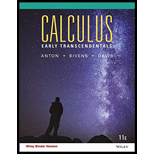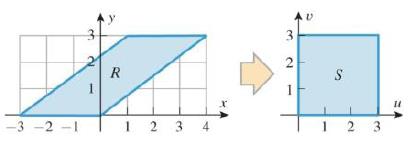
Find a transformation

Want to see the full answer?
Check out a sample textbook solution
Chapter 14 Solutions
CALCULUS EARLY TRANSCENDENTALS W/ WILE
Additional Math Textbook Solutions
Precalculus: Concepts Through Functions, A Unit Circle Approach to Trigonometry (4th Edition)
Calculus & Its Applications (14th Edition)
Precalculus Enhanced with Graphing Utilities
Calculus: Early Transcendentals (2nd Edition)
Calculus: Single And Multivariable
- Determine the centroid in the y [units]arrow_forwardLet (x,y) have pdf f(x,y) = 1 over the region R = triangle with vertices (0,0), (1,0), (0,2) and f(x,y) = 0 elsewhere. Define Z = 2X + Y, W = 2X. a) Inverse transformation from (z,w) to (x,y) b) Jacobian J = c) sketch the region R in (x,y) coordinates d) sketch the region D in (z,w) coordinates e) Joint pdf over D, g(z,w) = f) Find pdf h(z) of Z from marginal of g(z,w) and sketch the graph H1arrow_forwardFind the global min and max of the provided function on the provided region R: f(x,y) = x - y - xy on the triangle R with vertices (0,0), (0,2), and (4,0)arrow_forward
- Find the image of the rectangular region in the z − plane formed by joining the points0, 0 , 2, 0 , 2, 1 , (0, 1) in the w − plane under the transformation,w = (1 +i )z − 2iInterpret both the regions graphically.arrow_forwardIdentify all extrema of the function f(x,y)=x³+y³-3x-12y +20 on the plane and characterize them.arrow_forwardaz. Suppose F = (2xz + 3y²) a, + (4yz²) a;. (a) Calculate S[F·dS, where S is the shaded surface in Figure 1. (c) Based on your results for parts (a) and (b), what named theorem do you think is being satisfied here, if any? (b) Calculate SF· dl, where C is the A → B → C → D → A closed path in Figure 1. az C C (0,1,1) D (0,0,0) (A ay В ax Figure 1: Figure for Problem 1.arrow_forward
- Find both parametric and rectangular representations for the plane tangent to r(u,v)=u2i+ucos(v)j+usin(v)kr(u,v)=u2i+ucos(v)j+usin(v)k at the point P(4,−2,0)P(4,−2,0).One possible parametric representation has the form⟨4−4u⟨4−4u , , 4v⟩4v⟩(Note that parametric representations are not unique. If your first and third components look different than the ones presented here, you will need to adjust your parameters so that they do match, and then the other components should match the ones expected here as well.)The equation for this plane in rectangular coordinates has the form x+x+ y+y+ z+z+ =0arrow_forwardLet S be the surface which is the graph of a C¹ function f(x, y) defined on an elementary region D. Then the area A(S) of S is given by 01/₂√₁+ 11 6₁ 1 + (f(x, y))² dxdy f(x, y) dxdy 2 √¹ - ² () - (or) af 1² dx ду D 2 °1/₂ √√₁ + ( 2 ) + ( )* dxd's af dy D f f 01/√√1+#+ / dx² дуг D xảy dxdyarrow_forward1.8 Consider the double integral ry I = dA 1² + y? where Ris the region of the XY plane, given in the attached graph. (2 - 2)* + v = 4 R (エ-1+=1 When transforming the previous integral applying change of variable in polar coordinates, we obtain rsin 0/ cos? e sin e cos 0 drdo A) I = sin 0 cos 0 drde + 2 cos e */6 J2 cos 0 7/4 B) I = /3 rsin 0/ cos e sin 0 cos 0 drde + sin 0 cos 0 drde 4 cos 0 r sin 0 cos 0 drde + /6 cos / sin? e C) I = r sin 0 cos 0 drde J2 cos 0 /6 /4 /3 sin 0/ cos D) I = r sin 0 cos 0 drdo + r sin 0 cos 0 drd0 */4arrow_forward
- i need the answer quicklyarrow_forwardLet F = -9zi+ (xe#z– 2xe**)}+ 12 k. Find f, F·dĀ, and let S be the portion of the plane 2x + 3z = 6 that lies in the first octant such that 0 < y< 4 (see figure to the right), oriented upward. Z Explain why the formula F · A cannot be used to find the flux of F through the surface S. Please be specific and use a complete sentence.arrow_forwardS^2 is the sphere, RP^2 is the real projective planearrow_forward
- Algebra & Trigonometry with Analytic GeometryAlgebraISBN:9781133382119Author:SwokowskiPublisher:Cengage
